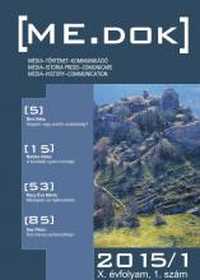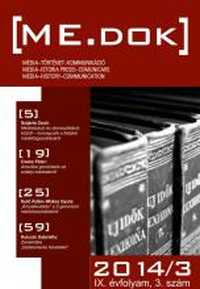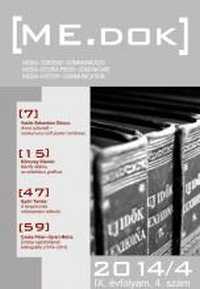
Médiapiac és tájékoztatás
The article analyze the situation of the Hungarian radio broadcast news in the context of the audiovisual market of Romania, in the period of time between January and June 2014.
More...We kindly inform you that, as long as the subject affiliation of our 300.000+ articles is in progress, you might get unsufficient or no results on your third level or second level search. In this case, please broaden your search criteria.

The article analyze the situation of the Hungarian radio broadcast news in the context of the audiovisual market of Romania, in the period of time between January and June 2014.
More...
If someone undertakes a thorough analysis of András Sütő’s „Anyám könnyű álmot ígér” – modestly called „diary notes” at fi rst publishing – they will have no doubt that the volume is the reincarnation of genuine sociography. This novel published in 90,600 copies between 1970–1976 – gained space in our consciousness as an emblematic creation of an era that survived itself – at a time when that era was still representing itself to be perpetual.Based on his analyses, Péter Cseke reaches the conclusion that it was the demand for historical discernment as well as the responsiblity of the written word that prompted András Sütő – who walked the minority cross-roads of knowing – to speak up in the end of the 60’s. Everything else follows from this: the academic level of demand in reality statements; the authenticity of personality, the personal character of the narrative; and the dilatation of the dimensions of how we interpret reality.
More...
The author presents some potential problems of radio and television speech, analyzing therelations between the two branches of the media. The article concludes that the TV did not causethe „death” of radio, as previously thought, but on the contrary: he helped it revive, renew. Radiopresenters are now motivated to use more plastic language to better adapt to different speakingsituations, to create „worlds” through their voice. We review the cases that cause „disruption”of optimal expression - ex.: rush, health problems, too complicated style of the text to be read/presented, etc.
More...
The article analyzes the concept of freedom, in relation to the attacks committed against Charlie Hebdo, a satirical review from France. The author states that the Euro-Atlantic population is convinced that he can impose rationalism which characterizes his culture to the other cultures - even by force of arms. The author defi nes and analyzes the concepts of „positive liberty” and „negative liberty” - by saying that these freedoms could only work complementing each other. The article reviews the aspects of the concept of freedom, analyzing the analogies and differences between the cultures of East and West in the interpretation of the concept of freedom.
More...
The author defi nes the radio as „the vocal arts bastion”, whose uses only the sounds ascommunicative environment (inarticulate – ex. nature, articulated - music, speech).This article presents a very detailed and reasoned criteria which must face a radio presenter.Are treated in detail the minimum criteria to be met to obtain the „microphone authorization „. Thearticle contains a detailed evaluation guide and a guide of right pronunciation of foreign words inHungarian.
More...
The possibilities of accessing the news are moreand more varied, which lead to the fragmentation of the public, and the blurring of the professional boundaries of journalism. Both these tendencies led to intense international research interest in thelast few years, which all started form the main idea, that newsreporting is one of the most importantsocial, political and cultural institutions.As online news-sites became more and more popular andchanges occured in the consumer habits, the Hungarian media in Romania underwent a quick andmostly undocumented change. This essay presents a general image of the thematic characteristicsof the Hungarian media in Romania, available in 2014.
More...
The possibilities of accessing the news are moreand more varied, which lead to the fragmentation of the public, and the blurring of the professional boundaries of journalism. Both these tendencies led to intense international research interest in thelast few years, which all started form the main idea, that newsreporting is one of the most importantsocial, political and cultural institutions.As online news-sites became more and more popular andchanges occured in the consumer habits, the Hungarian media in Romania underwent a quick andmostly undocumented change. This essay presents a general image of the thematic characteristicsof the Hungarian media in Romania, available in 2014.
More...
The possibilities of accessing the news are moreand more varied, which lead to the fragmentation of the public, and the blurring of the professional boundaries of journalism. Both these tendencies led to intense international research interest in thelast few years, which all started form the main idea, that newsreporting is one of the most importantsocial, political and cultural institutions.As online news-sites became more and more popular andchanges occured in the consumer habits, the Hungarian media in Romania underwent a quick andmostly undocumented change. This essay presents a general image of the thematic characteristicsof the Hungarian media in Romania, available in 2014.
More...
In this article the author presents a detailed portrait of Károly Kós, writer, illustrator, journalist,architect, important public and political fi gure. The author concludes: Kós, who witnessed thetragic events of the century – in which the Hungarians have suffered enormous losses – alwaysmaintained a pragmatic realism, and even if he had to endure the consequences of two world wars,always managed to help his community, and published important articles that had resounding echoand important cultural and social effects.
More...
The study is trying to present the analyzing schemes that can be suitable to interpret the students’ ways of communication and their habits of using the media. Three major traditions are mentioned, trends which can be described by the concepts of mediatization, diffusion of innovations and domestication. We try to fi nd arguments for the fact that mainly the latter approach can offer – theoretical and methodological – opportunities which make it possible to recognize the different groups of this generation more precisely.
More...
At the invitation of Hungarian Communion of Friends of America, Professor Péter Cseke presented a series of conferences about the media situation in Transylvania. In the article below we present an excerpt from his lectures, showing how is the use of new media among youth in Transylvania, which law applies to online journalism, which is the situation in Transylvania printed media, what are the online news sites that are most popular among the Hungarian communities from Romania, which is the newes magazine published in Hungarian in Transylvania (Nőileg), which is the relationship with the press in Transylvania from Hungary, what is the situation of the freedom of the press etc.
More...
This is a comprehensive study which was carried out at the University of Pécs in 2013 as part of a wider scientific research program entitled ‘Dissemination and Acknowledgement of Scientific Achievements’. The main objective of the program is to convey the scientific results of the University of Pécs to youngsters living in the vicinity of the institution. In order to achieve this, we need to be aware of the patterns of communication in this certain age group. Through our project we would like to establish a data base which in the future may help to get in touch with the target group more efficiently. The research may help to gain a better understanding of how the so called ‘Generation Z’ communicates. The paper below summarizes the most important findings of the project.
More...
According to common sense,youngsters are more likely to turn their backs on politics. However, in my paper I would like to throw some light on the subject by introducing a new form of mediated political reflexivity on various social and cultural issues. The phenomenon works through humorous and parodistic videos which are based on remixes of popular movies, songs, talk-shows and news items and are circulating on social websites. Quite often the“actors” of these videos are “everyday celebrities” such as the homeless, the poor and the socially deprived.My hypothesis is that ridicule is a symbolic act through which youngsters distance themselves from social injustices while order is re-established. In conclusion, youngsters who tend to reject taking part in serious political acts can still make their voice heard in these videos.
More...
Nowadays it is essential foremost people to be familiar with and able to use communication technology. Children get to know computers at an early age, later at secondary school and university they use Internet on a regular basis. They use Internet to chat with their friends as well as an important source of information. Our research interest was whether university students participate in physical activity, and if so, from where they acquire relevant information. Furthermore we examined if there is a correlation between sporting habits and sports related information accessible on university web pages.
More...
My PhD-thesis deals with the musical life of Cluj as reflected in the local Hungarian press between 1970-2010. The aspects of the musical life are presented through the journalistic genres,especially critical writing. In this essay I’ll give an analysis of the relationship between musical criticism and audience, and I’ll also mention how the performing musicians themselves interpreted musical criticism.
More...
The present study aimed to reflects on fieldwork methodology based on field experiences of 24 months. The population of village situated on the periphery of Transylvanian Plain(Câmpia Transilvaniei/Erdélyi Mezőség) is divided into four ethnic groups and seven religious denominations. The research focusing on interethnic co-existence made it necessary to introduce a new conception which expresses the social researcher’s attitude toward the locals. I attempted to complete the dichotomizing, schematizing conceptions of researching the „own” and „other” cultured in ethnology/anthropology with the description of term „neighboring” culture, which has a methodological significance, at the same time could give explications as well for the history of interethnic researches.
More...
In his article the author investigates the methods of improvement of the brand of Romania by cultural instruments, by the “soft power” weapon. Dâncu considers that it is a mistake ignoring the improvement of the public image of Romania accusing the lacks of the “hard power” (economy) of the country. In the interpretation of the author the best method of winning a “cognitive war” of the future – and emending the brand of Romania – is the effective synthesis of the “soft power”, the artistic and the cultural realizations with the “hard power”, which can immerge in a very efficient “smart power”.
More...
Prominent member of the interwar Hungarian literature in Transylvania, Miklós Bánffy played an important role in the social events of those times. He was noted as a public figure, as a politician, but the most striking of its achievements are literary works – otherwise often criticized by his contemporaries. Könczey makes us known also the forgotten side of his work, namely graphics. The author presents Bánffy’s eclectic graphics, proving that his achievements are of a high artistic level. Bánffy’s portfolio has very different styles, he mastered various techniques (watercolor, ink, pencil, chalk etc.). Noteworthy are caricatures of Bánffys (noted especially „Memorials of Fortéjos Deák Boldizsár” - chef d’oeuvre of his work), many of whom signed with the name of Miklós Kisbán or Ben Myll. Bánffy illustrated numerous books of the Corporation of Hungarian writers from Transylvania.
More...
In this paper the author presents two magazines named „Napkelet”, edited in Cluj-Napoca and Budapest. The magazine „Napkelet”, edited in Cluj (1920-1922) was an important open forum for research and ideas. Editor: Paál Árpád. The magazine focus on solving theHungarian’s problems in Transylvania, but it was also an aggregator of important cultural achievements. Editors said that the fate of Hungarians in the Carpathian Basin must be interpreted in a European context. The magazine „Napkelet”in Budapest (1923-1940) is characterized best by the writer Cécile Tormay (editor of the magazine), which defines the role of the publication „Napkelet” as „broken bridge among regions „, „pending dawn even during dark nights.” The study includes presentations of writers: Lajos Áprily, Sándor Reményik, Áron Tamási, etc.
More...
Bibliography of Transylvanian Press History (1919–2014)
More...